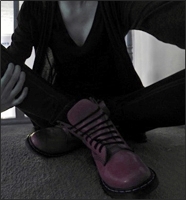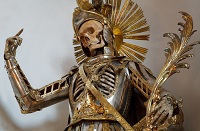2














| Thumbs Up |
| Received: 25 Given: 0 |

In 2006, a lone climber attempting the summit of Mount Everest for the third time was, purely by chance, caught in an amateur photograph taken by another climber of the scenic mountaintop ahead. The climber in the photograph was making his way up what is known as the Final Push of the Northeast ridge, between Camp VI at 8,230 m and the summit. It was late in the afternoon, a foolishly reckless time to undertake the lengthy and dangerous route.
It would be many hours before the the photographer and his climbing team saw the man again. Leaving the camp at the recommended time, shortly before midnight in order to reach the summit at daybreak, they were first in line of a total of roughly 40 climbers attempting the Final Push that day. A long train of men, all tethered to the lengths of rope permanently in place to keep climbers on the right track.
For decades, this rope had taken climbers within a few feet of what became known as Green Boots cave. A small limestone overhang located at 8500 m, it was already infamous among climbers for the same reason it earned its nickname. For the past ten years, the body of a climber who died in 1996 has been a grim landmark for every climber of the Northeast route, lying curled up in the fetal position, wearing fluorescent green mountaineering boots.
This morning, however, Green Boots had company. Sitting no more than two feet to the left of the corpse was a man who at first glance appeared to be dead. His gloved hands were on his knees, his hood and hat cast his face in shadow. The only feature visible was the man's severely frostbitten nose, already a greenish black hue. On closer inspection, the vapor from the man's breath could be seen rising.
What happened next entered the folklore of the highest mountain on earth. Every man interviewed gives a different story. What is certain is that every single one of the 40-odd climbers attempting the summit that day left the man in the cave, whose name was David Sharp, to freeze, either by choice, by ignorance, or by misjudging him as a corpse they already expected to see in that infamous cave.
While chilling in itself, the incident pales in the bigger context of the deadliness of Mount Everest. For every ten climbers who have ever reached the summit, the mountain has claimed one of them. In the 56 years since the first men in history reached the top, 216 people have died, and the grim reality of the horrific conditions of the Final Push is that 150 bodies have never been, and likely can never be, recovered. They are all still there, and located, almost without exception, in the Death Zone.
The term Death Zone was originally coined by a Swiss Doctor named Edouard Wyss-Dunant in his 1952 book, "The Mountain World". Wyss-Dunant, who almost reached the summit of Everest during the 1952 Swiss Everest Expedition (the peak was finally climbed a year later by Norgay and Hillary), dramatically portrayed the effects of altitude on human physiology and defined a number of acclimatization zones. He termed the highest of these zones the Todeszone (German for Death Zone) and demarked it to begin at the 7,500 meter (24,606 feet) altitude level. At this altitude and above, Wyss-Dunant stated, not only could normal human functions not be maintained, but they rapidly deteriorated – even with the use of supplemental oxygen.
The Death Zone has since been readjusted to 8,000 meters (26,240 feet), for a variety of reasons.
Above a certain altitude, no human can ever acclimatize. Only on 14 mountains worldwide can one step beyond the 8000 meter mark and know that no amount of training or conditioning will ever allow you to spend more than 48 hours there. The oxygen level in the Death Zone is only one third of the sea level value, which in simple terms means the body will use up its store of oxygen faster than breathing can replenish it.
In such conditions, odd things happen to human physical and mental states. A National Geographic climber originally on Everest to document Brian Blessed's (ultimately botched) attempt at summiting, described the unsettling hallucinogenic effects of running out of oxygen in the Death Zone. The insides of his tent seemed to rise above him, taking on cathedral-like dimensions, robbing him of all strength, clouding his judgement. Any stay in the Death Zone without supplementary oxygen is like being slowly choked, all the while having to perform one of the hardest physical feats imaginable.
Lack of oxygen and treacherous terrain are not the only challenges on Everest, however. Ascents are very rarely attempted outside a very short window between May and June when conditions are at their absolute best, with average temperatures of -27 degrees Celsius, and 50 mph winds. But Mount Everest is so high that the top actually penetrates into the stratosphere, where winds known as Jet Streams can flow up to 200 mph, driving temperatures down to minus 73 degrees Celsius.
Any exposed skin at high altitudes, even at the best of conditions, are prone to frost bite. A reaction to extreme cold, frost bite starts when blood vessels in the skin contract to preserve core body temperature, in conditions where normal blood flow would lead to the body cooling dangerously fast.
Over time, if the exposed areas of skin are not heated, the lack of blood flow causes tissue death and, even if reheated, gangrene. At this stage, amputations are common.
Climbers are by no means ignorant of these facts. They are reiterated in every source, in every article, and somehow adds to the dangerous allure of the mountain.
But in the words of David Brashears, five time summiteer of Everest, "there had been nothing in my training to prepare me to pass through the open graveyard waiting above."
The case of Hannelore Schmatz is an infamous one. On October 2, 1979, after a successful summit, and for reasons unclear, she died of exhaustion 100 meters short of reaching Camp IV. For years, any climber attempting the southern route could see her body, sitting, leaning against her backpack with her eyes open and brown hair blowing in the wind. Despite being so exposed and so visible along the well-trodden climbing route, rescue operations are virtually suicidal in the Death Zone. A Nepalese police inspector and a Sherpa who tried to recover Hannelore's body in 1984 both fell to their deaths. It was finally high winds that blew her remains over the edge and down the Kangshung face.
An area along the northeast route to the summit has earned the unassuming nickname of "Rainbow Valley", simply because of the multicolored down jackets of the numerous corpses littering the hillside. Even in the harsh conditions of lethal altitudes, corpses can remain for decades, some appearing frozen in time with climbing gear intact.
Brashears explains, "Despite the snow and ice, Everest is as dry as a desert, the sun and wind quickly mummify human remains." The picture below serves as an example, it shows the corpse of mountaineer George Mallory, lost on Everest in 1924, and the state in which it was found in 1999 after 75 years exposed.
No study has ever been done on the causes of death on Everest, what it is that makes people sit down and give up sometimes within shouting distance of safety. But climbers refer to a kind of confrontation with fear that they experience at a certain point up the mountain. The realization that, not only will you not be able to help anyone else in trouble, but if you mess up, in any way, no one will likely be able to help you either.
Media termed it "summit fever", the apparent callousness that drives mountaineers to disregard ethics on their Everest ascents, sometimes literally climbing over dead bodies to reach their goals. But whatever the preparation and outlandish cost, perhaps it's not simply ruthless determination that makes someone abandon their team mates, and yet still have the energy to summit. In such alien conditions, utterly hostile to human life, climbers might face their own mortality. Under the specter of pure, unadulterated fear, they must realize that they are beyond help as well as beyond helping anyone else.
If they don't, they fall among those who never leave, abandoned on Everest.
More on The Death Zone:National Geographic's The Dark Side Of Everest
Credits to Jägerstaffel and godhead@blogspot.
"Bowie could appear on TV, denounce mass immigration, propose a return to 'blood and soil',
then lead us in a national rendition of Magic Dance to bring us all together"

[YOUTUBE]HQJQapyHAQg[/YOUTUBE]
[YOUTUBE]clvehmQz6ro[/YOUTUBE]
[YOUTUBE]x8sj4zhyhlc[/YOUTUBE]
[YOUTUBE]ibBi6_2NrEI[/YOUTUBE]
[YOUTUBE]bivOZDjBobg[/YOUTUBE]
In the Death Zone, you are literally dying, no human body can operate for long under those conditions - there is no room for error if survival is your concern. I find the open-air graveyard aspect of it is interesting. The bodies litter the trek serving as a reminder of mortality.
Last edited by Jägerstaffel; 05-22-2011 at 06:13 PM.

The actions of certain climbers highly suspect.
Anatoli Boukreev did not use supplementary oxygen during his ascent, which is somewhat common for a climber but not for a guide.
Scott Fischer, a team leader, may have ignored the effects of a chronic and very serious illness as well as self-imposed time-frames to avoid bad weather to reach the summit;
In some cases; the actions of some climbers were amazingly brave.
Rob Hall risked it all to stay with Doug Hanson who was unable to descend from the summit, and lost his life as a result.
Beck Weathers was abandoned twice (possibly three times, depending on interpretation) on the mountain but trudged back to camp on his own power despite some of the worst frostbite ever seen.

Last edited by Jägerstaffel; 06-10-2011 at 04:39 AM. Reason: 96 Disaster















| Thumbs Up |
| Received: 10,204 Given: 10,750 |

Mt Everest Is Littered With Dead Bodies
By The Deuce on Saturday, August 24, 2013
“On my expedition there was no way that you would have left a man under a rock to die. It simply would not have happened.” —Edmund Hillary
In A Nutshell
Despite being one of the most difficult places on earth to reach, Mount Everest is plagued by trash, leftover gear, and yes, even dead bodies. Many climbers have been lost, and Everest does not make reclaiming them an easy task.
The Whole Bushel
Ever since Mount Everest was first summitted by Edmund Hillary and Tenzing Norgay in 1953 (or was it George Mallory and Andrew Irvine in 1924?), mountain climbers and adventure enthusiasts from all walks of life have dreamed of reaching the highest peak on Earth. As the costs of expeditions have come down over the years and technology has improved, a huge wave of climbers take on the mountain every year.
A long way removed from the “leave no trace” camping that most recreational campers follow these days, the trail to the top of Everest from base camp is littered with remnants from previous expeditions. Along the way to the top, climbers find hundreds of used oxygen bottles, mounds of frozen human waste, and the many fallen climbers who now call Everest their final resting place.
Unfortunately, tragedies occur on Everest every year. Sherpas and other guides are hired to guide climbers to the top but not to carry trash or corpses down with them. While some families spend thousands of dollars to find and recover the bodies of loved ones, an estimated 150-200 bodies still remain on the mountain face.
Some bodies have been covered in snow and typically aren’t visible, but some bodies are seen right along the route. Climbers report that some are in natural positions: as if they are just resting or taking a nap. It’s not unusual for the person’s last facial expression to be forever frozen onto their face. Some have gained notoriety as landmarks and have been given names. Green Boots is the name given to a fallen climber who eternally rests in a small cave. Every climber who takes the popular Northeast Ridge encounters Green Boots.
Recently, awareness of the amount of waste on Everest has increased. Some groups have been organized to collect trash and bodies from the mountain, but some recovery operations are impossible due to location and altitude. Additional efforts are being made by the Nepalese government and others to restrict the amount of climbers given permission to climb each year.
Maxed Out on Everest
Show Me The Proof
The deadly business of climbing Everest
source















| Thumbs Up |
| Received: 19,981 Given: 24,682 |

That would be pretty grim, kind of ruin the experience.















| Thumbs Up |
| Received: 10,204 Given: 10,750 |















| Thumbs Up |
| Received: 19,981 Given: 24,682 |

Out Of Africa Theory is a lie.
http://www.theapricity.com/forum/sho...88#post3431588
And a mighty angel took up a stone like a great millstone, and cast it into the sea, saying, Thus with violence shall that great city Babylon be thrown down, and shall be found no more at all.

















| Thumbs Up |
| Received: 427 Given: 0 |

Mt. Everest has around 200 dead bodies on the mountain. It is nearly impossible for recovery of a body off the mountain. Most of the bodies are in the same exact position they were when they died. Perfectly preserved in time because of the cold. Along the route up to the summit climbers will pass all these bodies. There are bodies over 50 years old that look like they were placed there yesterday.
The "death zone" is 26,000 feet. Air is so thin that there is no margin for error. Immediate frostbite will happen. Lack of oxygen leaves climber bewildered and weak. Cost for one to go on a trip is $25,000.
Several bodies are given names. This one is "green boots". Many of the bodies are now landmarks along the way up. "green Boots" has been there since 1996.
“PLEASE don’t leave me,” the dying woman cried.
There was an American flag placed on this woman years later and a note from her family. Two people found the woman alone and barely alive but could do nothing to help her. They thought about that moment everyday and saved up all their money for 8 years to make a return trip and give her a proper "burial".
Here's one of George Mallory where he has lain since falling to his death in 1924
Bodies lay exactly where the climber last took a "rest". Most of the time they take a rest and dont wake up.
http://sometimes-interesting.com/201...mount-everest/














| Thumbs Up |
| Received: 3,303 Given: 2,746 |

Creepingly good condition..

















| Thumbs Up |
| Received: 427 Given: 0 |

There are currently 1 users browsing this thread. (0 members and 1 guests)
Bookmarks